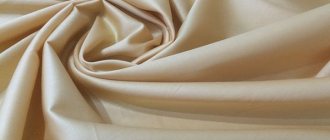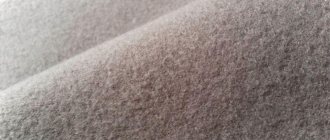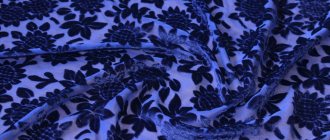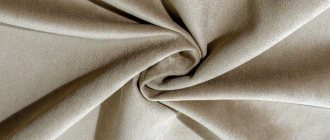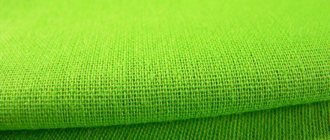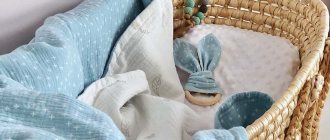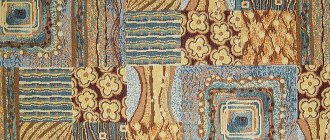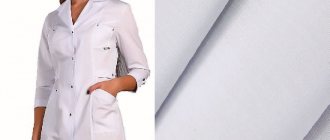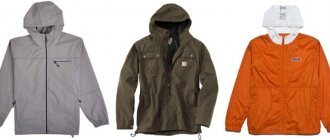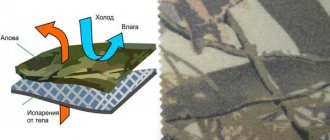Home / Different composition
Back
Published: 01/03/2021
Reading time: 2 min
0
169
Molton fabric has similar features to flannel. The material, woven from natural raw materials, has retained the same production technology as three centuries ago. It is distinguished by its softness, “fluffiness” and high thermal insulation properties.
- 1 Origin
- 2 Raw materials and manufacturing
- 3 Properties: positive and negative
- 4 Use and care of products
- 5 Reviews
- 6 Conclusion
What type of fabric is this?
Molton is a dense, soft matte fabric with double-sided brushing and double-face weave of threads.
The fabric is made from natural raw materials of animal or plant origin, therefore a distinction is made between wool and cotton fabrics.
Molton colors
Molton is produced everywhere, but some European countries, such as Poland and Austria, can be called leaders.
Catalog of fabrics made from natural fibers
Raw materials and manufacturing
Wool molt fabric is produced in several stages:
- preparation of wool fibers. Processing involves sorting threads and removing biological contaminants;
- flushing This is necessary to eliminate residual debris and dust;
- drying. The raw materials are pressed out, dried and prepared for further processing.
Before being sent to the machine, the threads undergo a series of procedures.
| Procedure | Description |
| Rewind | The yarn is rewound from small bobbins to bobbins of larger diameter. The task is to increase the length of the threads and remove any remaining debris. |
| Tape warping | Winding the threads into individual tapes onto a warping drum, which is part of the weaving machine. |
| Sizing | The fibers are wetted with a softening solution. This is necessary to prevent thread breakage and improve glide. |
| Parting | Making the base of the fabric, evenly distributing the threads. |
For information! Following the order of preparatory actions leads to the production of molton fabric with the original twill weave.
Origin story
The history of the material began in the 17th century. There is still a debate about the origin of molton. According to one version, this is a derivative of the French word “mollet”, which describes the soft texture of molton. According to another, the name is consonant with the English city of Melton, which is why it is considered the birthplace of the canvas.
Initially, moulton consisted mainly of wool. It was spun from worsted or melange yarn using the twill method. The material itself was expensive, so not all segments of the population could afford to purchase it.
Care instructions
Preserving the fluffy pile and attractive properties of the material will ensure proper care.
- Wash fleece items by hand or in a machine turned on in a gentle mode. Detergents must have a mild formula.
- To prevent shrinkage, the water heating temperature should be limited to 30°.
- Items made from fleece will rarely need to be ironed. If necessary, ironing is carried out from the wrong side of a slightly damp product. The temperature regulator is set to the position corresponding to the type of fiber.
Fabric composition and its properties
In addition to cotton and wool bases, polyester and elastane are added to modern fabrics to improve their properties. Molton is characterized by double-sided brushing, and the rep pattern of weaving forms a relief pattern.
Elastane
Artificial elastane fabric: from production and properties to areas of use
more details
Polyester
Popular synthetic fabric polyester: what is known about its characteristics and areas of application?
more details
The most valuable properties are the naturalness and softness of the material. Products made from moulton are flexible, durable and at the same time comfortable to wear. The material holds heat well and does not lose its shape.
Reviews
Users noted high performance characteristics. The material does not wrinkle, holds its shape, and is aesthetically attractive. The lack of elasticity is compensated by strength.
The main competitive advantage is heat retention. The material maintains comfortable conditions during climate changes (lower temperatures, increased humidity, gusts of wind).
Among the dissatisfaction is the labor-intensive care of the products. However, following the recommendations extends the life of things.
Types of fabric
Types of molton:
- Classical. Double-sided pile.
- Satin. Single sided fabric. On the one hand it looks like moulton, and on the other it looks like satin.
- Stage. Characterized by a high degree of darkness and sound absorption. Practically does not wrinkle and straightens well. More dense structure.
- Muleton: synthetic (one layer consists entirely of polyester), combined (a mixture of polyester and cotton), natural (completely made of natural raw materials, no synthetics).
- Bolton. Single-sided fabric. It has a rough surface on one side only. Refers to decorative moulton.
Product use and care
Molton is a fabric intended for sewing clothes and home textiles. It also serves as the basis for creating a muleton. This is the material that is spread on the table. Protects the surface from high temperatures and spilled liquids. Another name is tablecloth. It is a thin fabric with fleece of varying degrees of density. Muleton is popular among restaurateurs and catering owners.
Author:
Zakharova Nina Afanasyevna
I hope you like my article! If you find any shortcomings, just write to me about it! I am always ready for a conversation and will answer any questions you have, ask them!
